Related Research Articles
2069 Hubble, provisional designation 1955 FT, is a carbonaceous asteroid from the outer region of the asteroid belt, approximately 40 kilometers in diameter. It was discovered on 29 March 1955, by the Indiana Asteroid Program at Goethe Link Observatory, United States, and named after American astronomer Edwin Hubble.
Abnoba, provisional designation 1900 FH, is a stony background asteroid from the central regions of the asteroid belt, approximately 40 kilometers in diameter. It was discovered on 4 June 1900, by astronomers Max Wolf and Arnold Schwassmann at the Heidelberg-Königstuhl State Observatory in southwest Germany. The asteroid was named after the Celtic deity Abnoba.
Hercynia, provisional designation 1900 FK, is a background asteroid from the outer regions of the asteroid belt, approximately 38 kilometers in diameter. It was discovered on 21 September 1900, by astronomers Max Wolf and Arnold Schwassmann at the Heidelberg-Königstuhl State Observatory in southwest Germany. The asteroid was named for the ancient Hercynian Forest, known to the Romans as "Hercynia silva".

950 Ahrensa, provisional designation 1921 JP, is a stony Phocaea asteroid and slow rotator from the inner regions of the asteroid belt, approximately 15 kilometers in diameter. It was discovered on 1 April 1921, by German astronomer Karl Reinmuth at Heidelberg Observatory in southern Germany.
1853 McElroy, provisional designation 1957 XE, is an asteroid from the outer region of the asteroid belt, approximately 21 kilometers in diameter. It was discovered on 15 December 1957, by the Indiana Asteroid Program at Goethe Link Observatory near Brooklyn, Indiana, United States, and named for American biochemist William D. McElroy.

1010 Marlene is a carbonaceous background asteroid from the outer regions of the asteroid belt, approximately 47 kilometers in diameter. It was discovered on 12 November 1923, by astronomer Karl Reinmuth at the Heidelberg-Königstuhl State Observatory in southwest Germany. The asteroid was named after German actress and singer Marlene Dietrich.
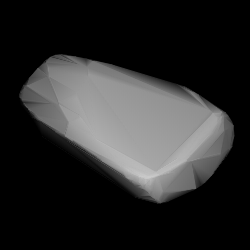
1069 Planckia, provisional designation 1927 BC, is a background asteroid from the outer regions of the asteroid belt, approximately 39 kilometers in diameter. It was discovered on 28 January 1927, by astronomer Max Wolf at the Heidelberg-Königstuhl State Observatory in Germany. The asteroid was named after German physicist Max Planck.
1043 Beate, provisional designation 1925 HB, is a stony asteroid from the outer region of the asteroid belt, approximately 32 kilometers in diameter. It was discovered by German astronomer Karl Reinmuth at the Heidelberg-Königstuhl State Observatory on 22 April 1925. Any reference of its name to a person is unknown.
3578 Carestia, provisional designation 1977 CC, is an extremely dark asteroid from the outer region of the asteroid belt, approximately 58 kilometers in diameter. It was discovered on 11 February 1977, by the staff of the Felix Aguilar Observatory at El Leoncito Complex in San Juan, Argentina. The asteroid was named after South American astronomer Reinaldo Carestia.
1815 Beethoven, provisional designation 1932 CE1, is a carbonaceous background asteroid from the outer regions of the asteroid belt, approximately 30 kilometers (19 miles) in diameter. It was discovered on 27 January 1932, by German astronomer Karl Reinmuth at the Heidelberg Observatory. The uncommon F-type asteroid seems to have a long rotation period of 54 hours (tentative). It was named after Ludwig van Beethoven.
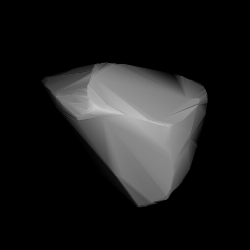
1582 Martir, provisional designation 1950 LY, is a carbonaceous background asteroid from the outer regions of the asteroid belt, approximately 37 kilometers in diameter. It was discovered on 15 June 1950, by Argentine astronomer Miguel Itzigsohn at the La Plata Astronomical Observatory in Argentina. The asteroid was named after the First Lady of Argentina, Eva Perón.

4547 Massachusetts is a dark background asteroid from the central regions of the asteroid belt, approximately 24 kilometers in diameter. It was discovered on 16 May 1990, by Japanese astronomers Kin Endate and Kazuro Watanabe at the JCPM Sapporo Station on the island of Hokkaido, Japan. The asteroid was named for the U.S. state of Massachusetts.
1243 Pamela, provisional designation 1932 JE, is a carbonaceous background asteroid from the outer regions of the asteroid belt, approximately 70 kilometers in diameter. It was discovered on 7 May 1932, by South African astronomer Cyril Jackson at the Union Observatory in Johnannesburg. The asteroid was named for Pamela Jackson, daughter of the discoverer.

1436 Salonta, provisional designation 1936 YA, is a dark background asteroid from the outer regions of the asteroid belt, approximately 60 kilometers in diameter. Discovered by György Kulin at the Konkoly Observatory in 1936, the asteroid was later named for the Romanian city of Salonta, the birthplace of the discoverer.

1424 Sundmania is a large asteroid and rather slow rotator from the background population of the outer regions of the asteroid belt. It was discovered on 9 January 1937, by astronomer Yrjö Väisälä at the Turku Observatory in southwest Finland. The dark X-type asteroid has a notably long rotation period of 93.7 hours and measures approximately 70 kilometers in diameter. It was named after Finnish astronomer and mathematician Karl F. Sundman.
1323 Tugela, provisional designation 1934 LD, is a dark background asteroid from the outer regions of the asteroid belt, approximately 60 kilometers in diameter. It was discovered on 19 May 1934, by South African astronomer Cyril Jackson at the Union Observatory in Johannesburg. The asteroid was named for the Tugela River in western South Africa.
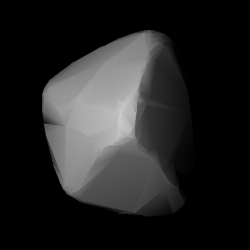
2120 Tyumenia is a dark background asteroid, approximately 45 kilometers in diameter, located in the outer regions of the asteroid belt. It was discovered on 9 September 1967, by Soviet astronomer Tamara Smirnova at the Crimean Astrophysical Observatory in Nauchnyj, on the Crimean peninsula. The asteroid was named for the now Russian district of Tyumen Oblast in Western Siberia.
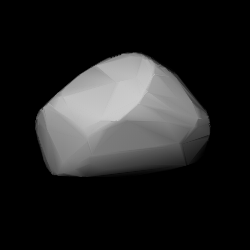
1276 Ucclia is a carbonaceous Alauda asteroid from the outer region of the asteroid belt, approximately 31 kilometers in diameter. It was discovered on 24 January 1933 by Belgian astronomer Eugène Delporte at the Royal Observatory of Belgium in Uccle. Two nights later, the body was independently discovered by Richard Schorr at Bergedorf Observatory in Hamburg, Germany. It was named for the Belgium city of Uccle and its discovering observatory.
3682 Welther, provisional designation A923 NB, is a background asteroid from the central regions of the asteroid belt, approximately 19 kilometers in diameter. It was discovered on 12 July 1923, by German astronomer Karl Reinmuth at the Heidelberg Observatory in southwest Germany. The asteroid has a rotation period of 3.6 hours. It was named after Barbara Welther, an American historian of science at CfA.
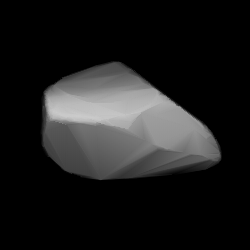
1301 Yvonne is a carbonaceous background asteroid from the background population of the intermediate asteroid belt, approximately 21 kilometers in diameter. It was discovered on 7 March 1934, by French astronomer Louis Boyer at the Algiers Observatory in North Africa. The asteroid was named for the discoverer's sister, Yvonne Boyer
References
- 1 2 3 4 5 6 "JPL Small-Body Database Browser: 3728 IRAS (1983 QF)" (2017-06-05 last obs.). Jet Propulsion Laboratory . Retrieved 4 July 2017.
- 1 2 Schmadel, Lutz D. (2007). "(3728) Iras". Dictionary of Minor Planet Names – (3728) IRAS. Springer Berlin Heidelberg. p. 315. doi:10.1007/978-3-540-29925-7_3725. ISBN 978-3-540-00238-3.
- 1 2 3 4 5 6 "LCDB Data for (3728) IRAS". Asteroid Lightcurve Database (LCDB). Retrieved 1 February 2016.
- 1 2 3 4 Masiero, Joseph R.; Mainzer, A. K.; Grav, T.; Bauer, J. M.; Cutri, R. M.; Nugent, C.; et al. (November 2012). "Preliminary Analysis of WISE/NEOWISE 3-Band Cryogenic and Post-cryogenic Observations of Main Belt Asteroids". The Astrophysical Journal Letters. 759 (1): 5. arXiv: 1209.5794 . Bibcode:2012ApJ...759L...8M. doi:10.1088/2041-8205/759/1/L8 . Retrieved 1 February 2016.
- 1 2 3 4 Usui, Fumihiko; Kuroda, Daisuke; Müller, Thomas G.; Hasegawa, Sunao; Ishiguro, Masateru; Ootsubo, Takafumi; et al. (October 2011). "Asteroid Catalog Using Akari: AKARI/IRC Mid-Infrared Asteroid Survey". Publications of the Astronomical Society of Japan. 63 (5): 1117–1138. Bibcode:2011PASJ...63.1117U. doi: 10.1093/pasj/63.5.1117 . (online, AcuA catalog p. 153)
- 1 2 3 Masiero, Joseph R.; Grav, T.; Mainzer, A. K.; Nugent, C. R.; Bauer, J. M.; Stevenson, R.; et al. (August 2014). "Main-belt Asteroids with WISE/NEOWISE: Near-infrared Albedos". The Astrophysical Journal. 791 (2): 11. arXiv: 1406.6645 . Bibcode:2014ApJ...791..121M. doi:10.1088/0004-637X/791/2/121 . Retrieved 5 December 2016.
- 1 2 3 4 Mainzer, A.; Grav, T.; Masiero, J.; Hand, E.; Bauer, J.; Tholen, D.; et al. (November 2011). "NEOWISE Studies of Spectrophotometrically Classified Asteroids: Preliminary Results". The Astrophysical Journal. 741 (2): 25. arXiv: 1109.6407 . Bibcode:2011ApJ...741...90M. doi:10.1088/0004-637X/741/2/90 . Retrieved 1 February 2016.
- 1 2 Warner, Brian D. (January 2009). "Asteroid Lightcurve Analysis at the Palmer Divide Observatory: 2008 May - September". The Minor Planet Bulletin. 36 (1): 7–13. Bibcode:2009MPBu...36....7W. ISSN 1052-8091 . Retrieved 1 February 2016.
- 1 2 3 Veres, Peter; Jedicke, Robert; Fitzsimmons, Alan; Denneau, Larry; Granvik, Mikael; Bolin, Bryce; et al. (November 2015). "Absolute magnitudes and slope parameters for 250,000 asteroids observed by Pan-STARRS PS1 - Preliminary results". Icarus. 261: 34–47. arXiv: 1506.00762 . Bibcode:2015Icar..261...34V. doi:10.1016/j.icarus.2015.08.007 . Retrieved 3 July 2016.
- 1 2 "3728 IRAS (1983 QF)". Minor Planet Center. Retrieved 1 February 2016.
- ↑ "10714 (1983 QG)". Minor Planet Center. Retrieved 3 July 2016.
- ↑ "JPL Small-Body Database Browser: 126P/IRAS". Jet Propulsion Laboratory. Retrieved 1 February 2016.
- ↑ "MPC/MPO/MPS Archive". Minor Planet Center. Retrieved 3 July 2016.